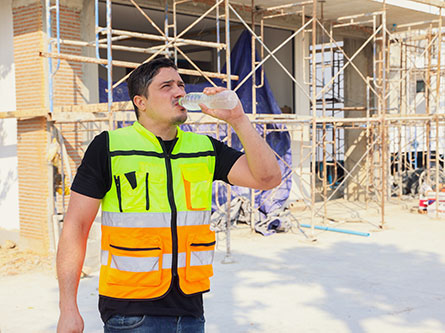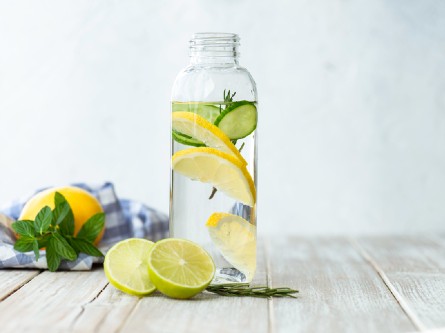When the summer heats up, many of us try to stay indoors as much as possible. But there are times when you need to be outside for work, events and activities.
Excessive heat can lead to dehydration, heat exhaustion and heat stroke. We explain the different symptoms you should look for and ways to help prevent and treat each one.
Dehydration
Dehydration happens when you aren't getting enough fluids. This can lead to your body not functioning properly. It is a cause of both heat exhaustion and heat stroke.
It doesn't just happen during excessive heat. Dehydration can also be caused by diarrhea, sweating, and vomiting.
Get these tips for diarrhea and constipation relief
Symptoms of dehydration
Thirst is often the first sign of dehydration. Other signs of mild to moderate dehydration include:
- Headache
- Fatigue
- Dry or sticky mouth
- Not urinating much
- Dark yellow urine
- Muscle cramps
- Low blood pressure
- Chills
- Flushed skin
- Lack of sweating
Signs of severe dehydration include the above, but also:
- Dizziness
- Rapid heartbeat
- Rapid breathing
- Fainting
- Sleepiness or lack of energy
Sign up for our Health Highlights e-newsletter
Ways to prevent dehydration
Drink plenty of water to prevent dehydration. You should also drink water before you're thirsty. People who work or need to be out in the heat should drink 8 oz. of water every 20 minutes. Even if you're inside, you should still remember to drink plenty of water when it's hot outside.
Avoid drinks with caffeine, such as iced coffee, soda, energy drinks and iced tea. Caffeine is dehydrating.
Instead, choose plain water, sparkling water or water infused with fresh fruit like cucumber or lemon. Electrolyte replacement drinks may be helpful for long stretches of outdoor activity.
Learn why it's important to drink water and stay hydrated
Heat exhaustion
Heat exhaustion is caused by your body's loss of water and salt. This is usually caused by a lot of sweating, especially in hot conditions. It's an early stage of heat stroke.
People who are at increased risk for heat exhaustion include:
- older adults
- children
- people who are overweight or obese
- people who have heart or other health conditions (such as diabetes or kidney disease)
- people taking certain medications.
Symptoms of heat exhaustion
If you notice someone with any of the symptoms of heat exhaustion, have them sit or lie down in a shady spot. You can also give them cold drinks and apply cool, wet cloths on their skin.
Heat exhaustion symptoms include:
- Overly tired or weak
- Nausea
- Dizziness or briefly passing out
- Cool or clammy skin that may appear flushed or pale
- Headache
- Heavy sweating
- High body temperature
If the person doesn't get better or the symptoms get worse, they should get medical care immediately.
Ways to prevent heat exhaustion
When the weather starts heating up, it can take a few weeks for your body to get used to it. Be mindful of this and increase your water intake.
If you usually exercise outdoors, do it during the early morning hours. The evenings can still be pretty warm, so be sure to wait until it's shady if you are going to exercise later in the day.
Wear lightweight clothing that is cool to the touch and breathable. Avoid synthetic fabrics like polyester that don't allow your body's natural cooling system to work.
If you are working outside or children are playing sports outdoors, take regular breaks. Schedule at least 10 minutes in the shade for every hour of work or activity. Children, older people and those who are not as fit need more rest.
Get some tips to stay healthy and cool during summer heat
Check out 5 tips to exercise safely when it's hot outside
Heat stroke
Heat stroke is a very dangerous condition. It happens when the body can no longer cool down properly. This can cause the body temperature to rise to 106° F rapidly. Heat stroke can cause permanent disability or death if emergency treatment isn't given.
Symptoms of heat stroke
When a person has heat stroke, they may stop sweating. They may also get what feels like chills although their body temperature is higher. Other symptoms may include:
- Confusion or slurred speech
- Loss of consciousness
- Hot, dry skin
- Seizures
- Extremely high body temperature (above 104° F)
- Rapid pulse and heart rate
If you see someone with these symptoms, call 911 right away.
In the meantime, move the person to a shaded area, and remove outer clothing. Cool the person quickly with cold water on the skin or by soaking clothes in cool water. You can also use a fan or other clothing to circulate air around the person to help with cooling.
Ways to prevent heat stroke
You can help prevent heat stroke in the same way you can prevent heat exhaustion. Drink lots of water, wear proper clothing, exercise at cooler times and take breaks in shady areas.
When is a heat illness an emergency?
Heat exhaustion isn't usually an emergency. If you or someone you know cools down in about 30 minutes, there isn't cause for concern.
However, if someone has signs of heat stroke listed above, call 911 immediately.
This blog was medically reviewed by occupational and environmental medicine physician Sheri Belafsky.




